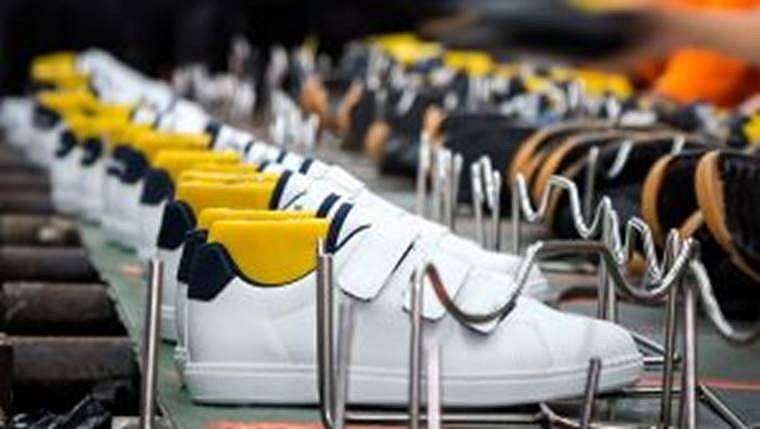 News
News
By the end of 2021, the country has about 2,200 footwear manufacturing enterprises in Vietnam, mainly in the area around Ho Chi Minh City. Ho Chi Minh. And earn about $20.78 billion from footwear exports by 2021. China - the world's largest footwear producer - is also home to the world's largest footwear spenders. While mainland spending on footwear was significantly lower, Hong Kong residents spent the largest amount on footwear globally, at $372 per capita in 2021.
 |
However, amid the current geopolitical environment, rising wages in China and disruptions caused by Covid, footwear manufacturers have increasingly moved their operations outside of the densely populated country. best of the world. As a result, Vietnam also benefits. Investors have become increasingly concerned about China 's zero-Covid policy and its impact on economic activity, especially in the manufacturing sector.
In a major incident in September 2021, China locked down the Putian shoemaking center after only 139 cases of virus infections. More than 500,000 workers and 4,200 shoe manufacturers for international and local brands are based in Putian, and the city produces more than 1.3 billion pairs of shoes a year. Lockdowns in places like Shanghai also have a significant impact on the footwear supply chain.
A footwear manufacturer with production facilities in Vietnam and Indonesia said that it was affected by a shortage of raw materials from China. As well as being a manufacturing hub for finished footwear, China produces the raw and synthetic materials used in footwear manufacturing in other parts of the world.
It is worth noting that Vietnam has issued similar orders, also affecting footwear manufacturers. Some factories are forced to close for months in 2021, and this has had a profound effect on the supply chain. However, Vietnam is now taking a more business-friendly approach. On March 16, 2022, the government announced the abolition of regulations on quarantine on entry to Vietnam.
However, it's not just the pandemic and China's response that are causing manufacturers to shift production facilities. Labor costs are a big factor. The data shows that Vietnam's labor costs are half of China's labor costs at US$2.99 (VND68,000) per hour compared with US$6.50 (VND148,000) per hour respectively. Other countries, especially those within ASEAN, are also becoming attractive to companies currently manufacturing outside of China, with comparable wages being a big influencing factor.
Vietnam's growing footwear industry
Vietnam may not have as much domestic demand as China, but the footwear industry is booming, exporting billions of pairs of shoes a year. The analysis shows that Vietnam will continue to benefit as footwear manufacturers move production bases from China to its southern neighbour. Data from the Observatory of Economic Complexity (OEC) shows that footwear is Vietnam's third largest export item in 2020. Vietnam's main footwear export market is the US (6.43 billion). USD), China ($2.24 billion), Germany ($1.03 billion), Japan ($953 million) and South Korea ($730 million). The OEC noted that Vietnam's fastest growing footwear export markets from 2019 to 2020 are China (USD 272 million), Poland (USD 25.6 million) and Taiwan (USD 22.6 million). USD).
The growth of the export market to China is perhaps indicative of a shift of production away from China. Big brands like Nike and Adidas have decided to locate their main production facilities in Vietnam. Nike has more than 100 suppliers in Vietnam, with 96 factories concentrated in the southern region. Adidas has also chosen Vietnam as its main production region – the 2020 annual report highlights that around 40% of total footwear production came from Vietnam in 2019.
In addition to lower labor costs compared to China, Vietnam has also signed major trade agreements, reducing tariffs and trade barriers for major markets. Comprehensive and Progressive Agreement for Trans-Pacific Partnership (CPTPP) - a trade agreement signed by Australia, Brunei, Canada, Chile, Japan, Malaysia, Mexico, New Zealand, Peru, Singapore and Vietnam - has also seen Vietnam's footwear exports to Canada and Mexico soar. However, data from Research and Markets highlights that local footwear businesses remain weak, amid financial and upgrading challenges.
Growth forecast
Analysis from Research and Markets shows that Vietnam's footwear production and exports are expected to continue to grow in 2022-2031. The team predicts a CAGR of 8.1% over the next 9 years. By 2031, the Research and Market Organization expects the Vietnamese footwear market to reach a whopping $38.7 billion - double the 2022 estimate of $19.1 billion. Much of Vietnam's growth can come as companies move out of China. Companies like Nike have emphasized their intention to increase production further in Vietnam. Other factors, including the availability of a young, driven workforce, may also influence companies moving operations from China to Vietnam.
However, local industry leaders note that the industry is still recovering from the end of 2021. While there may be strong orders, one business leader said there are only 80 % of workers have returned from the pandemic and this is holding back production. Meanwhile, there will be business competition from other developing ASEAN countries, such as Indonesia and Malaysia, both of which have a young workforce with low wages compared to China.